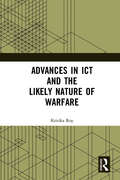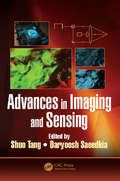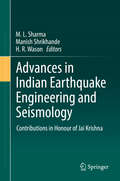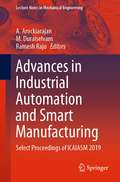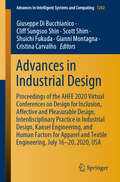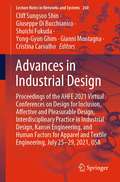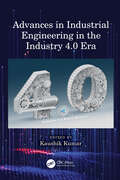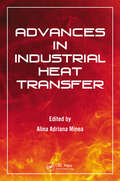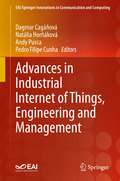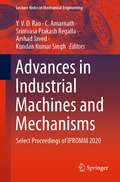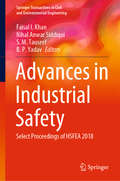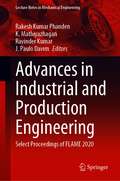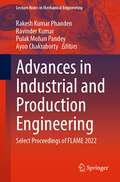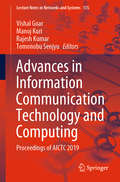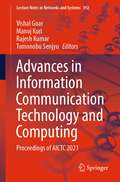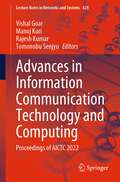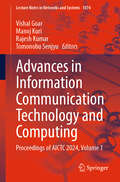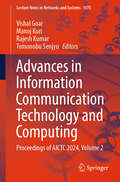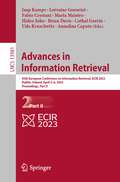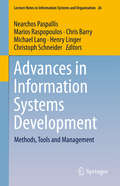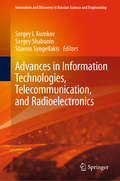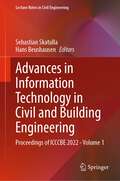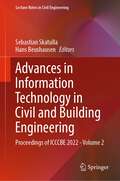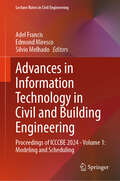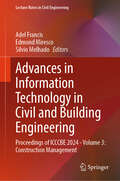- Table View
- List View
Advances in ICT and the Likely Nature of Warfare
by Kritika RoyThis book focuses on how advances in ICT have brought about a sea change in the way people work, live and share while also making them vulnerable. These advances exhibit a fundamentally reformed global context for development that has not just been restricted to the civilian domain but has simultaneously impacted the military domain. The exponential pace of advances in the field of Artificial Intelligence (AI), robotics, big data, quantum computing or IoT (Internet of Things) pioneers a significantly different vision of work and society. The current trends in warfighting present a very blurred picture of the future operating environment, but they give some shape to its likely direction. Military forces are trying to become much more flexible and have been adapting to these changes while emphasizing the importance of innovation and improvisation in order to counter challenges emanating from future scenarios. In this context, the book highlights the changing military strategies and tactics across nations vis-à-vis the hanging and emerging ICT technologies. It also highlights the importance of looking at present institutions, legal frameworks and principles as well as at the restraining factors inherent in realpolitik in order to understand if nation states are ready. Please note: Taylor & Francis does not sell or distribute the Hardback in India, Pakistan, Nepal, Bhutan, Bangladesh and Sri Lanka
Advances in Imaging and Sensing (Devices, Circuits, and Systems)
by Shuo Tang, Daryoosh Saeedkia and Krzysztof IniewskiThis introductory, yet in-depth, book explains the physical principles of electronic imaging and sensing and provides the reader with the information necessary to understand the design, operation, and practical applications of contemporary electronic imaging and sensing systems. The text has strong practical focus and contains examples of biomedical applications of optical electronic imaging and sensing. Each chapter draws upon the authors’ extensive research, teaching, and industrial experience and provides a useful resource for undergraduate and graduate students, as well as a convenient reference for scientists and engineers working in the field of electronic imaging and sensing.
Advances in Indian Earthquake Engineering and Seismology: Contributions in Honour of Jai Krishna
by M. L. Sharma Manish Shrikhande H. R. WasonThis edited volume is an up-to-date guide for students, policy makers and engineers on earthquake engineering, including methods and technologies for seismic hazard detection and mitigation. The book was written in honour of the late Professor Jai Krishna, who was a pioneer in teaching and research in the field of earthquake engineering in India during his decades-long work at the University of Roorkee (now the Indian Institute of Technology Roorkee). The book comprehensively covers the historical development of earthquake engineering in India, and uses this background knowledge to address the need for current advances in earthquake engineering, especially in developing countries. After discussing the history and growth of earthquake engineering in India from the past 50 years, the book addresses the present status of earthquake engineering in regards to the seismic resistant designs of bridges, buildings, railways, and other infrastructures. Specific topics include response spectrum superposition methods, design philosophy, system identification approaches, retaining walls, and shallow foundations. Readers will learn about developments in earthquake engineering over the past 50 years, and how new methods and technologies can be applied towards seismic risk and hazard identification and mitigation.
Advances in Industrial Automation and Smart Manufacturing: Select Proceedings of ICAIASM 2019 (Lecture Notes in Mechanical Engineering)
by A. Arockiarajan M. Duraiselvam Ramesh RajuThis book comprises selected peer-reviewed proceedings of the International Conference on Advances in Industrial Automation and Smart Manufacturing (ICAIASM) 2019. The contents focus on innovative manufacturing processes, standards and technologies used to implement Industry 4.0, and industrial IoT based environment for smart manufacturing. The book particularly emphasizes on emerging industrial concepts like industrial IoT and cyber physical systems, advanced simulation and digital twin, wireless instrumentation, rapid prototyping and tooling, augmented reality, analytics and manufacturing operations management. Given the range of topics covered, this book will be useful for students, researchers as well as industry professionals.
Advances in Industrial Design: Proceedings of the AHFE 2020 Virtual Conferences on Design for Inclusion, Affective and Pleasurable Design, Interdisciplinary Practice in Industrial Design, Kansei Engineering, and Human Factors for Apparel and Textile Engineering, July 16–20, 2020, USA (Advances in Intelligent Systems and Computing #1202)
by Shuichi Fukuda Giuseppe Di Bucchianico Cliff Sungsoo Shin Gianni Montagna Cristina Carvalho Scott ShimThis book addresses current research trends and practice in industrial design. Going beyond the traditional design focus, it explores a range of recent and emerging aspects concerning service design, human–computer interaction and user experience design, sustainable design, virtual & augmented reality, as well as inclusive/universal design, and design for all. A further focus is on apparel and fashion design: here, innovations, developments and challenges in the textile industry, including applications of material engineering, are taken into consideration. Papers on pleasurable and affective design, including studies on emotional user experience, emotional interaction design and topics related to social networks make up a major portion of the contributions included in this book, which is based on five AHFE 2020 international conferences (the AHFE 2020 Virtual Conference on Design for Inclusion, the AHFE 2020 Virtual Conference on Interdisciplinary Practice in Industrial Design, the AHFE 2020 Virtual Conference on Affective and Pleasurable Design, the AHFE 2020 Virtual Conference on Kansei Engineering, and the AHFE 2020 Virtual Conference on Human Factors for Apparel and Textile Engineering) held on July 16–20, 2020. Thanks to its multidisciplinary approach, it provides graduate students, researchers and professionals in engineering, architecture, computer and materials science with extensive information on research trends, innovative methods and best practices, and a unique bridge fostering collaborations between experts from different disciplines and sectors.
Advances in Industrial Design: Proceedings of the AHFE 2021 Virtual Conferences on Design for Inclusion, Affective and Pleasurable Design, Interdisciplinary Practice in Industrial Design, Kansei Engineering, and Human Factors for Apparel and Textile Engineering, July 25-29, 2021, USA (Lecture Notes in Networks and Systems #260)
by Shuichi Fukuda Giuseppe Di Bucchianico Cliff Sungsoo Shin Gianni Montagna Cristina Carvalho Yong-Gyun GhimThis book addresses current research trends and practice in industrial design. Going beyond the traditional design focus, it explores a range of recent and emerging aspects concerning service design, human–computer interaction and user experience design, sustainable design, virtual and augmented reality, as well as inclusive/universal design, and design for all. A further focus is on apparel and fashion design: here, innovations, developments and challenges in the textile industry, including applications of material engineering, are taken into consideration. Papers on pleasurable and affective design, covering studies on emotional user experience, emotional interaction design and topics related to social networks, are also included. Based on the AHFE 2021 International Conferences on Design for Inclusion, Interdisciplinary Practice in Industrial Design, Affective and Pleasurable Design, Kansei Engineering, and Human Factors for Apparel and Textile Engineering, held virtually on 25–29 July 2021, from USA, this book provides, researchers and professionals in engineering, design, human factors and ergonomics, human computer interaction and materials science with extensive information on research trends, innovative methods and best practices, and is expected to foster collaborations between experts from different disciplines and sectors.
Advances in Industrial Engineering in the Industry 4.0 Era
by Kaushik KumarAt the core of this book are several application areas where Industry 4.0 has been, or can be, applied. This book introduces the Fourth Industrial Revolution, with discussions and reflections that will lead the reader into a deeper understanding of the nature of the concept. This book also reveals various facets that can be applied and utilized for implementation of the concept in various sectors. This book:• Comprehensively discusses skills for Industry 4.0 • Provides insights into the application of Industry 4.0 in the healthcare sector • Presents involvement of Industry 4.0 in current concepts such as supply chain and blockchain • Showcases innovative additive manufacturing to enhance human・machine co-working • Includes virtualization and simulation techniques for decision-making in manufacturing and assembly processes This book is primarily written for graduate students and academic researchers in the fields of industrial engineering, manufacturing engineering, mechanical engineering, production engineering, and aerospace engineering.
Advances in Industrial Heat Transfer (Heat Transfer)
by Alina Adriana MineaAdvances in Industrial Heat Transfer presents the basic principles of industrial heat transfer enhancement. Serving as a reference and guide for future research, this book presents a complete approach, from redesigning equipment to the use of nanofluids in industry.Based on the latest methods of the experiment and their interpretation, this book pr
Advances in Industrial Internet of Things, Engineering and Management (EAI/Springer Innovations in Communication and Computing)
by Dagmar Cagáňová Natália Horňáková Pedro Filipe Cunha Andy PuscaThis book presents the trends, challenges, and advances in Internet of Things (IoT) in the areas of industrial management and industrial engineering. The authors look at how smart environments (smart city, smart university, smart regions, smart transportation, etc.) affect the way industrial management and industrial engineering are envisioned, planned, and applied and how engineers must incorporate new ideas and methods now and in the future. Some topics include the impact of ICT on the emergency response vehicle driving time, car accident detecting systems based on machine learning algorithms, smart city platforms based on citizen reporting services, and IoT-based household energy consumption prediction using machine learning. The book brings together contributions from academics and practitioners from around the world to discuss the intersection of IoT, industry and management.
Advances in Industrial Machines and Mechanisms: Select Proceedings of IPROMM 2020 (Lecture Notes in Mechanical Engineering)
by Y. V. D. Rao C. Amarnath Srinivasa Prakash Regalla Arshad Javed Kundan Kumar SinghThis book presents the select proceedings of the 1st International 13th National Conference on Industrial Problems on Machines and Mechanism (IPRoMM 2020) and examines issues in the design, manufacture, and performance of mechanical and mechatronic elements and systems that are employed in modern machines and devices. The topics covered include robotics, industrial CAD/CAM systems, mechatronics, machinery associated with conventional and unconventional manufacturing systems, material handling and automated assembly, mechanical and electro-mechanical systems of modern machinery and equipment, micro-devices, compliant mechanisms, hybrid electric vehicle and electric vehicle mechanisms, acoustic and noise control. This book also discusses the recent advances in the integration of IoT and Industry 4.0 in mechanism and machines. The book will be a valuable reference for academicians, researchers, and professionals interested in the design and development of industrial machines.
Advances in Industrial Safety: Select Proceedings of HSFEA 2018 (Springer Transactions in Civil and Environmental Engineering)
by S. M. Tauseef Nihal Anwar Siddiqui Faisal I. Khan B. P. YadavThis book presents the proceedings of the International Conference on Health, Safety, Fire, Environment, and Allied Sciences. It highlights latest developments in the field of science and technology aimed at improving health and safety in the workplace. The volume comprises content from leading scientists, engineers, and policy makers discussing issues relating to industrial safety, fire hazards and their management in industry, forests and other settings. Also dealt with are issues of occupational health in engineering, process and agricultural industry and protection against incidents of arson and terror attacks. The contents of this volume will be of interest to researchers, practitioners, and policy makers alike.
Advances in Industrial and Production Engineering: Select Proceedings of FLAME 2020 (Lecture Notes in Mechanical Engineering)
by Ravinder Kumar J. Paulo Davim Rakesh Kumar Phanden K. MathiyazhaganThis book comprises the select proceedings of the 2nd International Conference on Future Learning Aspects of Mechanical Engineering (FLAME) 2020. In particular, this volume discusses different topics of industrial and production engineering such as sustainable manufacturing processes, logistics, Industry 4.0 practices, circular economy, lean six sigma, agile manufacturing, additive manufacturing, IoT and Big Data in manufacturing, 3D printing, simulation, manufacturing management and automation, surface roughness, multi-objective optimization and modelling for production processes, developments in casting, welding, machining, and machine tools. The contents of this book will be useful for researchers as well as industry professionals.
Advances in Industrial and Production Engineering: Select Proceedings of FLAME 2022 (Lecture Notes in Mechanical Engineering)
by Ravinder Kumar Ayon Chakraborty Rakesh Kumar Phanden Pulak Mohan PandeyThis book comprises the select proceedings of the 3rd Biennial International Conference on Future Learning Aspects of Mechanical Engineering (FLAME) 2022. It aims to provide a comprehensive and broad-spectrum picture of state-of-the-art research and development in industrial and production engineering. Various topics covered include sustainable manufacturing processes, logistics & supply chains, Industry 4.0 practices, circular economy, lean six sigma, agile manufacturing, additive manufacturing, IoT and Big Data in manufacturing, 3D printing, simulation, manufacturing management and automation, surface roughness, multi-objective optimization and modelling for production processes, developments in casting, welding, machining, and machine tools and many more advancements in industrial and production engineering. This volume will prove a valuable resource for those in academia and industry working in the area of industrial and production engineering.
Advances in Information Communication Technology and Computing: Proceedings of AICTC 2019 (Lecture Notes in Networks and Systems #135)
by Rajesh Kumar Tomonobu Senjyu Vishal Goar Manoj KuriThis book features selected research papers presented at the International Conference on Advances in Information Communication Technology and Computing (AICTC 2019), held at the Government Engineering College Bikaner, Bikaner, India, on 8–9 November 2019. It covers ICT-based approaches in the areas ICT for energy efficiency, life cycle assessment of ICT, green IT, green information systems, environmental informatics, energy informatics, sustainable HCI and computational sustainability.
Advances in Information Communication Technology and Computing: Proceedings of AICTC 2021 (Lecture Notes in Networks and Systems #392)
by Rajesh Kumar Tomonobu Senjyu Vishal Goar Manoj KuriThe book is a collection of best selected research papers presented at the International Conference on Advances in Information Communication Technology and Computing (AICTC 2021), held in Government Engineering College Bikaner, Bikaner, India, during 20–21 December 2021. The book covers ICT-based approaches in the areas of ICT for energy efficiency, life cycle assessment of ICT, green IT, green information systems, environmental informatics, energy informatics, sustainable HCI or Artificial intelli computational sustainability.
Advances in Information Communication Technology and Computing: Proceedings of AICTC 2022 (Lecture Notes in Networks and Systems #628)
by Rajesh Kumar Tomonobu Senjyu Vishal Goar Manoj KuriThe book is a collection of best selected research papers presented at the International Conference on Advances in Information Communication Technology and Computing (AICTC 2022), held in Government Engineering College Bikaner, Bikaner, India during 17 – 18 December 2022. The book covers ICT-based approaches in the areas of ICT for Energy Efficiency, Life Cycle Assessment of ICT, Green IT, Green Information Systems, Environmental Informatics, Energy Informatics, Sustainable HCI, or Computational Sustainability.
Advances in Information Communication Technology and Computing: Proceedings of AICTC 2024, Volume 1 (Lecture Notes in Networks and Systems #1074)
by Rajesh Kumar Tomonobu Senjyu Vishal Goar Manoj KuriThe book is a collection of best selected research papers presented at the International Conference on Advances in Information Communication Technology and Computing (AICTC 2024), held in NJSC South Kazakhstan State Pedagogical University, Shymkent City, Kazakhstan, during April 29–30, 2024. The book covers ICT-based approaches in the areas of ICT for energy efficiency, life cycle assessment of ICT, green IT, green information systems, environmental informatics, energy informatics, sustainable HCI, or computational sustainability.
Advances in Information Communication Technology and Computing: Proceedings of AICTC 2024, Volume 2 (Lecture Notes in Networks and Systems #1075)
by Rajesh Kumar Tomonobu Senjyu Vishal Goar Manoj KuriThe book is a collection of best selected research papers presented at the International Conference on Advances in Information Communication Technology and Computing (AICTC 2024), held in NJSC South Kazakhstan State Pedagogical University, Shymkent City, Kazakhstan, during April 29–30, 2024. The book covers ICT-based approaches in the areas of ICT for energy efficiency, life cycle assessment of ICT, green IT, green information systems, environmental informatics, energy informatics, sustainable HCI, or computational sustainability.
Advances in Information Retrieval: 45th European Conference on Information Retrieval, ECIR 2023, Dublin, Ireland, April 2–6, 2023, Proceedings, Part II (Lecture Notes in Computer Science #13981)
by Brian Davis Hideo Joho Fabio Crestani Cathal Gurrin Lorraine Goeuriot Jaap Kamps Udo Kruschwitz Maria Maistro Annalina CaputoThe three-volume set LNCS 13980, 13981 and 13982 constitutes the refereed proceedings of the 45th European Conference on IR Research, ECIR 2023, held in Dublin, Ireland, during April 2-6, 2023. The 65 full papers, 41 short papers, 19 demonstration papers, 12 reproducibility papers consortium papers, 7 tutorial papers, and 10 doctorial consortium papers were carefully reviewed and selected from 489 submissions. The book also contains, 8 workshop summaries and 13 CLEF Lab descriptions. The accepted papers cover the state of the art in information retrieval focusing on user aspects, system and foundational aspects, machine learning, applications, evaluation, new social and technical challenges, and other topics of direct or indirect relevance to search.
Advances in Information Systems Development: Methods, Tools And Management (Lecture Notes in Information Systems and Organisation #26)
by Michael Lang Christoph Schneider Chris Barry Henry Linger Nearchos Paspallis Marios RaspopoulosThis volume features a collection of papers on emerging concepts, significant insights, novel approaches and ideas in information systems development. It examines advances in information systems development in general, and their impact on the development of new methods, tools and management. <P><P> The book draws on selected invited papers from the 26th International Conference on Information Systems Development (ISD) held in Larnaca, Cyprus, September 6 - 8, 2017. The revised and expanded papers present research that focuses on methods, tools and management in information systems development. These issues are significant as they provide the basis for organizations to identify new markets, support innovative technology deployment, and enable mobile applications to detect, sense, interpret and respond to the environment.
Advances in Information Technologies, Telecommunication, and Radioelectronics (Innovation and Discovery in Russian Science and Engineering)
by Stavros Syngellakis Sergey I. Kumkov Sergey ShabuninThe book is devoted to problems of information technologies (description and processing signals, especially ones corrupted by noises and disturbances) and to problems of telecommunications and production of advanced equipment in radio-electronics developed at the Ural Federal University, Ekaterinburg, Russia. It describes the contemporary state of the art and the development of methods for solving problems of signal processing and building equipment for practical solutions. The volume is mainly a collection of ideas, techniques and results in the field of video information technologies and various related applications of numerical methods. It comprises 18 chapters grouped under four main topics: image processing and computer vision, signal processing and navigation, simulation of some practical processes and computations for antennas, and applications of microwaves. The research described in this volume is addressed to a wide audience of scientists, engineers and mathematicians involved in the above mentioned four scientific topics.
Advances in Information Technology in Civil and Building Engineering: Proceedings of ICCCBE 2022 - Volume 1 (Lecture Notes in Civil Engineering #357)
by Hans Beushausen Sebastian SkatullaThis book gathers the latest advances, innovations, and applications in the field of information technology in civil and building engineering, presented at the 19th International Conference on Computing in Civil and Building Engineering (ICCCBE), held in Cape Town, South Africa on October 26-28, 2022. It covers highly diverse topics such as BIM, construction information modeling, knowledge management, GIS, GPS, laser scanning, sensors, monitoring, VR/AR, computer-aided construction, product and process modeling, big data and IoT, cooperative design, mobile computing, simulation, structural health monitoring, computer-aided structural control and analysis, ICT in geotechnical engineering, computational mechanics, asset management, maintenance, urban planning, facility management, and smart cities. Written by leading researchers and engineers, and selected by means of a rigorous international peer-review process, the contributions highlight numerous exciting ideas that will spur novel research directions and foster multidisciplinary collaborations.
Advances in Information Technology in Civil and Building Engineering: Proceedings of ICCCBE 2022 - Volume 2 (Lecture Notes in Civil Engineering #358)
by Hans Beushausen Sebastian SkatullaThis book gathers the latest advances, innovations, and applications in the field of information technology in civil and building engineering, presented at the 19th International Conference on Computing in Civil and Building Engineering (ICCCBE), held in Cape Town, South Africa on October 26-28, 2022. It covers highly diverse topics such as BIM, construction information modeling, knowledge management, GIS, GPS, laser scanning, sensors, monitoring, VR/AR, computer-aided construction, product and process modeling, big data and IoT, cooperative design, mobile computing, simulation, structural health monitoring, computer-aided structural control and analysis, ICT in geotechnical engineering, computational mechanics, asset management, maintenance, urban planning, facility management, and smart cities. Written by leading researchers and engineers, and selected by means of a rigorous international peer-review process, the contributions highlight numerous exciting ideas that will spur novel research directions and foster multidisciplinary collaborations.
Advances in Information Technology in Civil and Building Engineering: Proceedings of ICCCBE 2024 - Volume 1: Modeling and Scheduling (Lecture Notes in Civil Engineering #628)
by Silvio Melhado Adel Francis Edmond MirescoThis book gathers the latest advances, innovations, and applications in the field of information technology in civil and building engineering, presented at the 20th International Conference on Computing in Civil and Building Engineering (ICCCBE), held in Montreal, Canada on August 25-28, 2024. It covers highly diverse topics such as BIM, construction information modeling, knowledge management, GIS, GPS, laser scanning, sensors, monitoring, VR/AR, computer-aided construction, product and process modeling, big data and IoT, cooperative design, mobile computing, simulation, structural health monitoring, computer-aided structural control and analysis, ICT in geotechnical engineering, computational mechanics, asset management, maintenance, urban planning, facility management, and smart cities. Written by leading researchers and engineers, and selected by means of a rigorous international peer-review process, the contributions highlight numerous exciting ideas that will spur novel research directions and foster multidisciplinary collaborations.
Advances in Information Technology in Civil and Building Engineering: Proceedings of ICCCBE 2024 - Volume 3: Construction Management (Lecture Notes in Civil Engineering #630)
by Silvio Melhado Adel Francis Edmond MirescoThis book gathers the latest advances, innovations, and applications in the field of information technology in civil and building engineering, presented at the 20th International Conference on Computing in Civil and Building Engineering (ICCCBE), held in Montreal, Canada on August 25-28, 2024. It covers highly diverse topics such as BIM, construction information modeling, knowledge management, GIS, GPS, laser scanning, sensors, monitoring, VR/AR, computer-aided construction, product and process modeling, big data and IoT, cooperative design, mobile computing, simulation, structural health monitoring, computer-aided structural control and analysis, ICT in geotechnical engineering, computational mechanics, asset management, maintenance, urban planning, facility management, and smart cities. Written by leading researchers and engineers, and selected by means of a rigorous international peer-review process, the contributions highlight numerous exciting ideas that will spur novel research directions and foster multidisciplinary collaborations.
